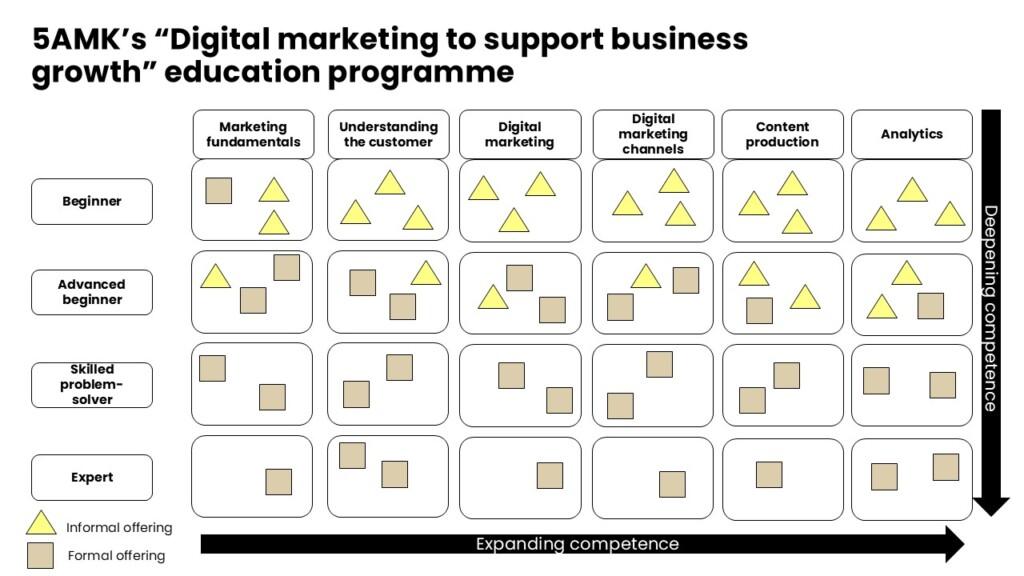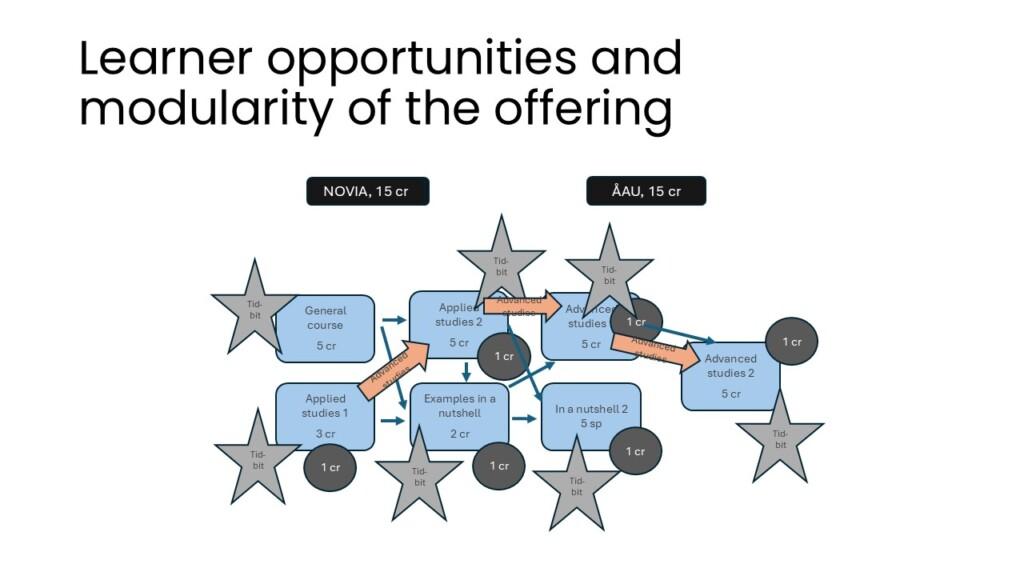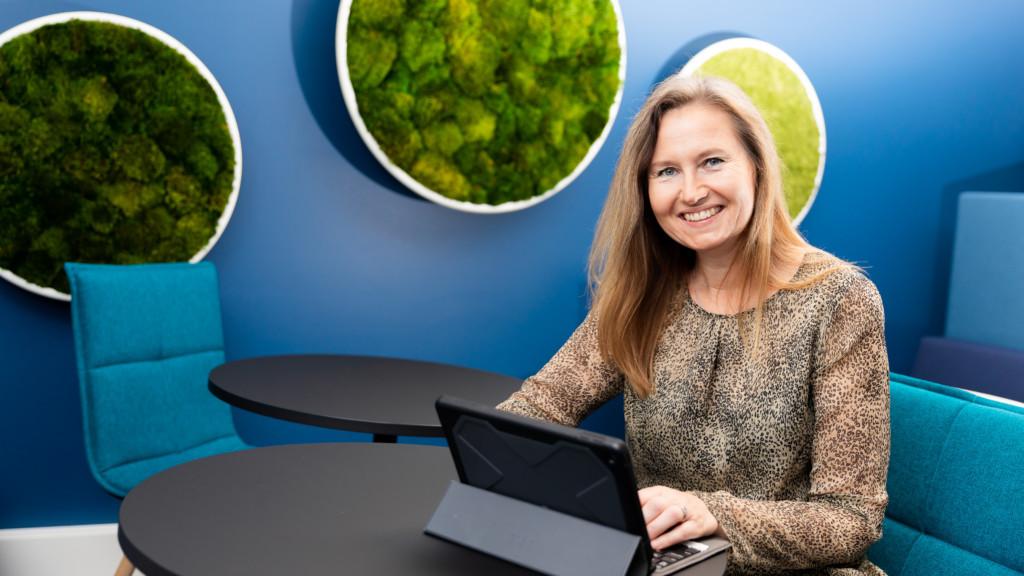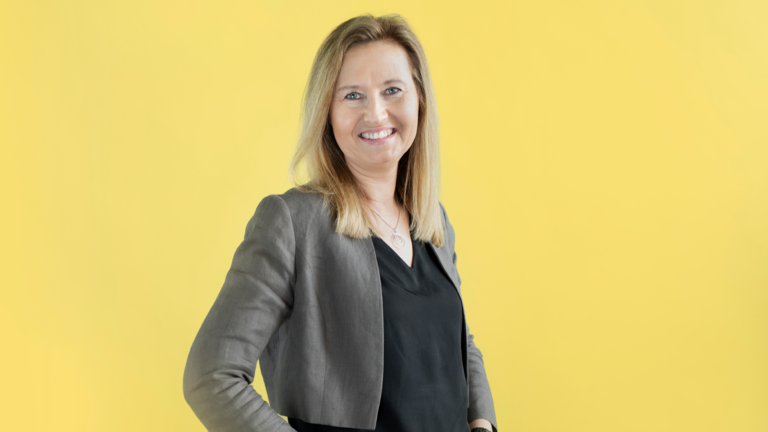Modular learning pathways were developed in 3.0 pedagogical pilot networks of higher education institutions in 2024–2025. Parts stacked in different ways create pathways that are particularly suitable for rapidly changing sectors. Functioning as a network, higher education institutions complement each other’s areas of competence, and the jointly created offering is unique as a whole.
The learning pathways of the pilot higher education institutions provide learners with different options for progressing on learning paths that utilise informal and formal offerings. It was also natural to combine the offerings of universities of applied sciences and universities in the learning pathways.
Modularity is already part of everyday life – continuous learners are now at the centre of the pilots
The modular learning pathways consists of independent, pedagogically-planned parts. Many personnel development training programmes follow modular paths. Services such as language instruction app Duolingo, Coursera and edX are also modular, which means that the courses are divided into smaller parts. Ideally, flexible modular progress inspires learning, as it enables the learner to select studies that are meaningful to them based on their prior learning.
Modular degree curricula are a routine aspect of higher education institutions, but now learning pathways have been specifically designed for continuous learners. The learning pathways of the pilot higher education institutions approached modularity from the perspectives of digital marketing, language mentors, youth work and preparatory studies for higher education mathematics. During the pilot, the focus was placed on the planning of learning pathways, while concrete implementations in higher education institutions will be made later.
In the Digivisio project, pedagogical pilots were used to come up with ideas for further development of the Opin.fi service. As implementations, learning pathways that produce novelty value are also close to micro-credentials, the framework for which will be completed by the Ministry of Education and Culture in 2026.
Several proposals for further development of the Opin.fi service
Micro-credentials, guidance and the functionalities and management of learning pathways in the Opin.fi service were co-created among pilot higher education institutions and as networks of higher education institutions. A summary of the final reports of pedagogical pilots was compiled for the Digivisio 2030 programme office. The summary presented the development targets.
The pilot higher education institutions highlighted the need for an illustrative presentation of learning pathways in the Opin.fi service. A visual overview tells the learner what the learning pathway is about. The learner can save a learning pathway that meets their needs in the My Learning section of the Opin.fi service. In the Opin.fi service, higher education institutions need to be given an opportunity to edit the information on a learning pathway so that the learner guidelines can be finalised. In addition to uniform descriptions of education, guidelines are supported by the classification of educational levels. The task of the AI tutor in the Opin.fi service is to primarily help learners find educational offerings and learning paths and remind them of ongoing learning.
Learning pathways offer flexibility and support for learners from different perspectives
Learning pathways adapting to the learner’s needs require careful advance planning from higher education institutions; learners might otherwise find themselves lost in the large number offerings available to them. In development projects, support for the learner’s choices was constructed in different ways
In addition to the contents of the learning pathways, 5AMK also takes into account the level of studies
5AMK utilised the draft framework for micro-credentials in the development of the Digital marketing for business growth learning pathway. Competence was described using the dimensions of knowledge, skills, responsibility and independence as well as in accordance with the Dreyfus Five-Stage Model of Skill Acquisition. AI was also used as a assistive tool.
Initially, the description of competence varied widely in different higher education institutions and it was also difficult to understand on which of the five competence levels a given offering might be placed. The “map” (figure below) of the learning pathway was considered a good tool for planning them, and the map template is also available to other higher education institutions in PowerPoint.

The Novia-Åbo Akademi University learning pathway includes “tasters” from study units
The “Ungdomsarbete” learning pathway continued prior cooperation between higher education institutions, and Opin.fi now offers a place for the joint offering. The learning pathway combines formal, informal and non-formal educational offerings and enables new learning paths within an learning pathway that includes a total of 60 credits.
The varying schedules of higher education institutions were found to be a challenge, which complicates learner-oriented planning. Making smaller “tasters” from study units offering multiple credits also requires resources and support services.

The learning pathway of the Tampere higher education community supports mathematical skills in the early stages of studies.
The University of Tampere and Tampere University of Applied Sciences have already worked together in the teaching of mathematics in a way that produces synergy benefits. An attractive refresher programme that leads learners to mathematics at the beginning of the learning path is a low-threshold opportunity for learners to complement their mathematics competence.
Solutions originally intended for continuous learners have also been found to be useful for degree students. An AI tutor is needed to identify the learner’s current competence and to recommend studies that are suitable for them. Moodle is used as the home base for learning materials, automatically reviewed assignments and peer assessments as well as guidance and Q&A classes held by teachers on campuses or remotely

The learning path developed by the University of Helsinki examines competence development from the perspective of the language awareness of both the learner and the workplace
The Language mentor learning pathway is based on the Kielibuusti project, which has developed language learning at the workplace in cooperation with HUS. The aim of the online learning pathway is to raise awareness of how a colleague or classmate can support learning Finnish or act as a language mentor in work and language training.
Informal content inspires language mentors to take formal studies (1-3 cr) and attracts them to other offerings related to the topic. Employer marketing and Career Services at the University of Helsinki support students in finding studies, along with Opin.fi themes (Renewal of working life and competence, Society and interaction) and the AI tutor.
The novelty value produced by the pilot for the University of Helsinki also includes combining informal and non-formal offerings with formal offerings as well as using learner profiles to outline the guidance needs of different learners.

Pedagogical pilots provided additional understanding of both cooperation between higher education institutions and further development of the Opin.fi service
The development pilots challenged higher education institutions to plan learning paths in new ways, particularly for continuous learners. The work also made the development needs of the Opin.fi service more specific with regard to higher education networks and jointly offered learning pathways.
In addition, the development of internal processes in higher education institutions is needed to implement new initiatives and national cooperation. A common understanding and practices among higher education institutions are needed, particularly in study descriptions, level classifications and an assessment of modular learning. Ideally, solutions aimed at continuous learners also enrich the learning paths of degree students.
Reports on pedagogical pilot development projects are available to all higher education institutions on their journey of transformation. You can read the reports here.

Satu Hakanurmi
Head of Development
University of Turku
Satu Hakanurmi served as an expert in digital pedagogy on the Digivisio 2030 project in 2021–2024. Together with the “pedaladies”, i.e. project manager Tuula Heide and coordinator Sini Hakala, several partial implementations were carried out. The vision for digital pedagogy specified the objectives of higher education pedagogy, and the work continued with the quality criteria for digital pedagogy. Internal processes of higher education institutions in the production of digitally supported study offerings were developed together with higher education institutions in the 2.0 pedagogical pilot , and 3.0 pedagogical pilots built modular learning pathways as higher education institution networks. 13 digital pedagogy studios were arranged and 12 e-learning training courses are openly available in the aoe.fi service. An education concept based on micro-learning was also awarded as the open learning and teaching practice of the year in 2024. Satu returned to her position in pedagogical development with the University of Turku in January 2025
What’s it all about?
In the Digivisio 2030 project’s 3.0 pedagogical pilot, higher education institutions developed modular learning pathways as networks. The pilot ran from 13 February to 14 February 2025, och Four development projects were presented at the final event of the pedagogy pilots in February. The pilot findings will be utilised in the development of the Opin.fi service.
The participants included:
– 5AMK network: Haaga-Helia University of Applied Sciences, Häme University of Applied Sciences, Laurea University of Applied Sciences, Metropolia University of Applied Sciences & South-Eastern Finland University of Applied Sciences
– Åbo Akademi University – Novia University of Applied Sciences
– Tampere University & Tampere University of Applied Sciences
